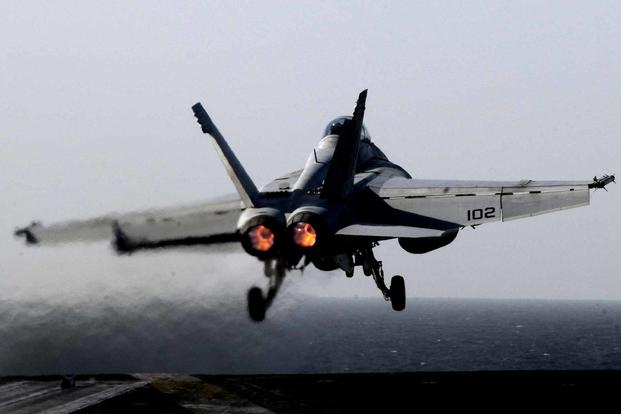Navy officials announced this week that they surpassed the Pentagon's call to get the service's fighter jet readiness rates way up after years of aviation readiness problems -- but the work isn't over, a two-star told reporters.
"Now we need to sustain it," Rear Adm. Shane Gahagan, the program executive officer for the Navy's Tactical Aircraft Programs, said Wednesday. "Now we have an equally challenging goal of sustaining these efforts."
When the military services were ordered to get 80% of their tactical aircraft ready for the fight, Navy officials decided to try to push the numbers even higher. They wanted 341 F/A-18 E/F Super Hornets and 93 EA-18G Growlers mission-capable and ready to deploy.
It was a daunting task. Only about 50% of the service's Super Hornets were considered mission-capable at the time. That meant about 260 were ready to deploy at a moment's notice. Leaders wanted 341 to be ready.
Related: Under the Wire, Navy Says it Has Met Mattis' Fighter Jet Readiness Deadline
"It was a number chosen internally to improve our aviation forces' ability to surge in time of need," Gahagan said the day after the service announced it had 343 Super Hornets and 95 Growlers ready to deploy.
To meet the call from former Defense Secretary Jim Mattis to push mission-capable rates on F-18s, F-35 Joint Strike Fighters, F-22 Raptors and F-16 Fighting Falcons up to 80%, the Navy turned to outside experts who deal with plane maintenance issues every day: commercial airliners.
They looked at how they could speed up maintenance, make fleet readiness centers operate more efficiently, and improve the supply chain so parts could get out to the fleet faster, Gahagan said.
"The commercial [partners] came and said, 'Hey, there's probably a better way to do some of those things,'" he said, with the biggest change being the addition of new maintenance operations centers and aircraft-on-ground, or AOG, cells.
A Navy news release that describes the AOGs said the concept had proven successful with commercial airliners. The idea is to have representatives from supply, engineering and industry quickly resolve problems on aircraft that have been grounded for a short time -- those that have flown in the last 160 days and have fewer than 10 problems.
"We have all the entities right there making decisions on what aircraft to go after," Gahagan said. "... That has proven very effective."
If the Navy is going to be ready to take on a near-peer adversary, it must maintain its high mission-capable rates on fighter aircraft, he added. Planes' readiness rates are assessed daily, he said, so they'll know quickly if they begin to see those levels dip again.
"When it gets to that number, that shows there's indicators that we're not sustaining," Gahagan said. "[We'll have to look at] where is that? What organization? And how can we stop those problems and get it back to where we are?
"We will know every day."
Editor's note: This story has been updated to correct Gahagan's rank.
-- Gina Harkins can be reached at gina.harkins@military.com. Follow her on Twitter @ginaaharkins.
Read more: Navy SEAL Leaders Claim They Were Wrongfully Fired, File IG Complaint













